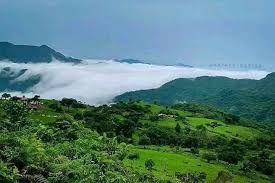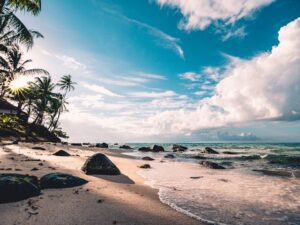The Mambilla Plateau, located in Taraba State, Nigeria, is a hidden gem that’s gaining popularity among tourists. This elevated region offers a unique blend of natural beauty, cool climate, and rich culture that sets it apart from other Nigerian destinations.
But what exactly draws people to this lesser-known destination? Let’s explore the many facets that make the Mambilla Plateau a must-visit location for both local and international tourists.
Natural Beauty That Takes Your Breath Away
The Mambilla Plateau’s stunning scenery is often the first thing that captures visitors’ hearts. Rising to heights of over 1,800 meters above sea level, it offers panoramic views that are unparalleled in Nigeria. Rolling hills carpeted in lush greenery stretch as far as the eye can see, creating a landscape that feels almost otherworldly in its beauty.
Visitors often find themselves mesmerized by the play of light and shadow across the plateau, especially during the golden hours of sunrise and sunset. The misty mornings, where low-hanging clouds drift between the hills, create an ethereal atmosphere that photographers and nature lovers alike find irresistible.
Waterfalls cascade down rocky cliffs, their sparkling waters a stark contrast to the verdant surroundings. The Chappal Waddi, Nigeria’s highest mountain, stands majestically within the plateau, offering a challenging climb for adventurous hikers and rewarding them with spectacular views from its summit.
A Climate That Refreshes and Rejuvenates
One of the most attractive features of the Mambilla Plateau is its pleasantly cool climate. While much of Nigeria experiences tropical heat, the plateau’s elevated position results in temperatures that rarely exceed 25°C (77°F), even during the hottest months.
This temperate weather is a major draw for visitors seeking respite from the sweltering conditions found in many other parts of the country. The cool, crisp air invigorates visitors, making outdoor activities enjoyable year-round. Many tourists describe the climate as “eternal spring,” with comfortable daytime temperatures and refreshingly cool nights.
The pleasant weather also contributes to the plateau’s agricultural success, allowing for the cultivation of crops that typically struggle in Nigeria’s hotter regions.
Biodiversity: A Nature Lover’s Paradise

The Mambilla Plateau’s unique ecosystem supports a rich variety of flora and fauna, many of which are found nowhere else in Nigeria. The region is home to several endangered species, making it a crucial area for conservation efforts and a fascinating destination for wildlife enthusiasts.
Bird watchers flock to the plateau to spot some of the over 300 bird species that inhabit or migrate through the area. Lucky visitors might catch a glimpse of the Mambilla white-throated monkey, a species endemic to this region.
The plateau’s diverse habitats, ranging from montane forests to grasslands, support a wide array of plant life. Botanists and plant enthusiasts can explore areas rich in medicinal plants, colorful wildflowers, and unique highland vegetation.
Adventurous Outdoor Activities for Every Taste
For those who crave active experiences, the Mambilla Plateau offers a wealth of outdoor activities. Hiking is particularly popular, with trails ranging from easy walks to challenging treks. These paths wind through varied terrain, offering hikers the chance to experience the plateau’s diverse landscapes up close.
Some notable hiking destinations include:
- Chappal Waddi: A challenging climb to Nigeria’s highest peak.
- Mayo Selbe: A scenic trail leading to beautiful waterfalls.
- Ngel Nyaki Forest Reserve: Offering glimpses of rare wildlife and plant species.

Camping enthusiasts can set up tents in designated areas, allowing for immersive experiences in nature. Waking up to misty mornings and the sounds of birds is an unforgettable experience for many visitors.
For those who prefer a more relaxed outdoor experience, numerous picnic spots offer stunning views and the chance to enjoy a meal amidst nature. Local guides often offer horseback riding tours, providing a unique way to explore the plateau’s rolling hills and valleys.
Cultural Riches and Meeting the People of the Plateau
The Mambilla Plateau is home to several indigenous groups, each with its own unique traditions and customs. Visitors have the opportunity to engage with these communities, learning about their way of life and experiencing their warm hospitality.
Cultural experiences might include:
- Witnessing traditional dances and music performances
- Participating in local festivals and ceremonies
- Learning about traditional crafts such as weaving and pottery
- Tasting local cuisine, often featuring fresh, locally-grown ingredients
Many communities offer homestay options, allowing visitors to immerse themselves fully in the local culture. These experiences often leave lasting impressions, with tourists praising the friendliness and generosity of the plateau’s inhabitants.
A Taste of Highland Agriculture
The Mambilla Plateau’s agricultural significance adds another layer to its appeal. The region is famous for its tea and coffee plantations, which thrive in the cool, humid climate.
Visitors can tour these plantations, learning about the cultivation and processing of these popular beverages. Many find it fascinating to see how the terrain and climate contribute to the unique flavors of Mambilla tea and coffee.
Some plantations offer tastings, allowing visitors to sample freshly brewed tea or coffee while enjoying panoramic views of the surrounding landscape. For many, sipping a cup of locally grown tea while overlooking mist-covered hills is a quintessential Mambilla Plateau experience.
Beyond tea and coffee, the plateau is known for its fruit orchards and vegetable farms. Agro-tourism experiences allow visitors to learn about sustainable farming practices and even participate in harvesting activities, depending on the season.
Challenges and Conservation Efforts
While the Mambilla Plateau’s natural beauty and cultural richness are its main attractions, it’s important to note the challenges facing this unique ecosystem. Deforestation and overgrazing have impacted some areas, threatening biodiversity and traditional ways of life.
However, various conservation initiatives are underway, aiming to protect the plateau’s natural resources while promoting sustainable tourism. Visitors can learn about these efforts and even participate in eco-friendly activities that support conservation goals.
Planning Your Visit
For those inspired to visit the Mambilla Plateau, it’s important to plan ahead. While accessibility has improved in recent years, the journey to the plateau can still be challenging. Most visitors arrive by road from major cities like Jalingo or Gembu.
Accommodation options range from basic guesthouses to more comfortable lodges. Many visitors opt for homestays with local families, which offer authentic cultural experiences.
The best time to visit depends on personal preferences. The dry season (November to March) offers clearer views and easier hiking conditions, while the rainy season (April to October) showcases the plateau at its lushest, with flowing waterfalls and blooming wildflowers.
Conclusion
The Mambilla Plateau offers a unique combination of natural beauty, pleasant climate, rich biodiversity, and cultural experiences that set it apart from other Nigerian destinations. Its appeal lies not just in its stunning landscapes, but in the way it allows visitors to connect with nature and local communities in meaningful ways.
If you’re seeking adventure, relaxation, or cultural insights, the Mambilla Plateau provides a memorable experience. As word spreads about this hidden gem, more travelers are discovering the allure of Nigeria’s highland paradise.
For those looking to explore beyond the well-trodden tourist paths, the Mambilla Plateau beckons with its misty hills, cool breezes, and warm smiles.
As Nigeria continues to diversify its tourism offerings, the Mambilla Plateau stands out as a shining example of the country’s potential for eco-tourism and cultural exchange. Its growing popularity is a testament to the enduring appeal of unspoiled landscapes and authentic experiences in our increasingly connected world.




